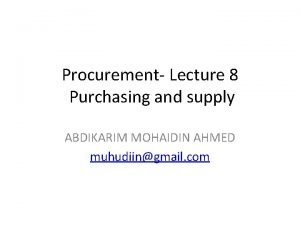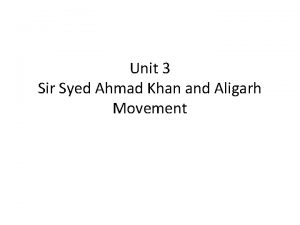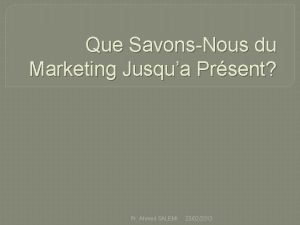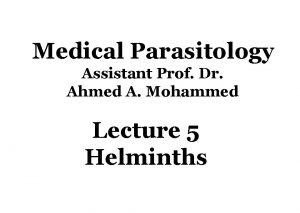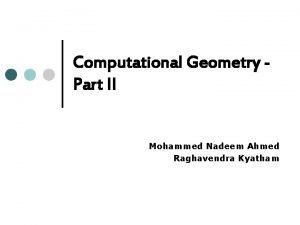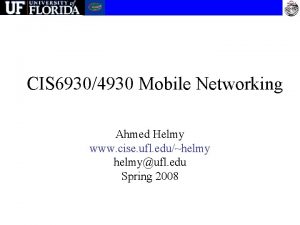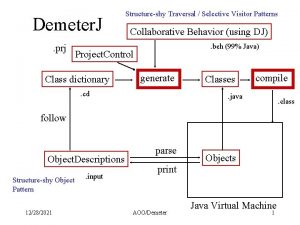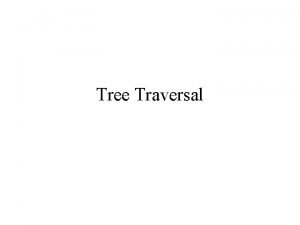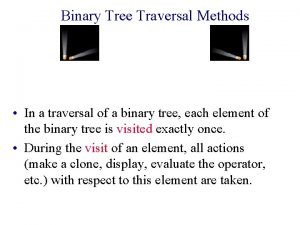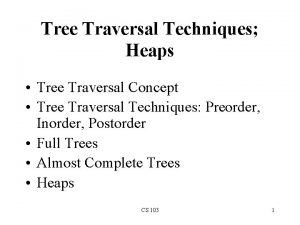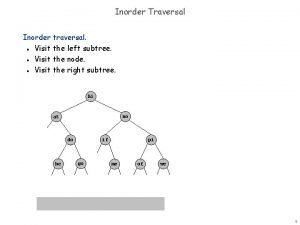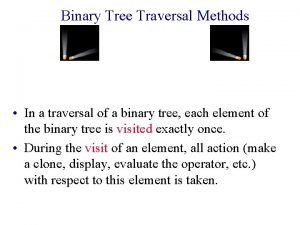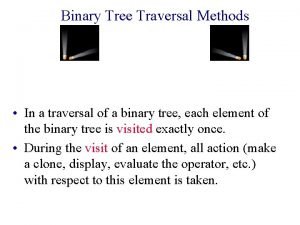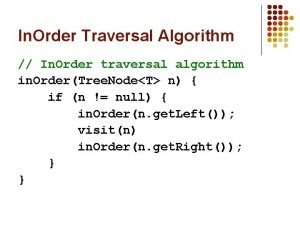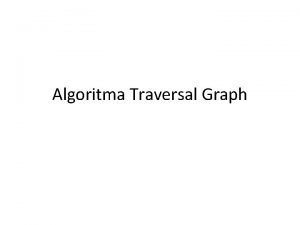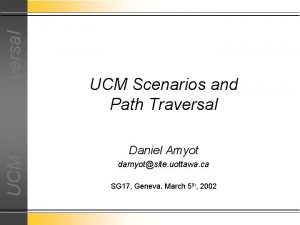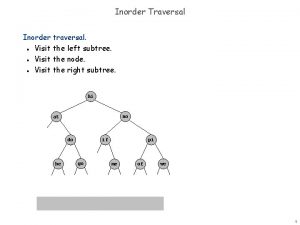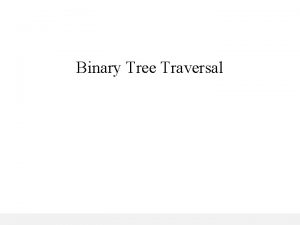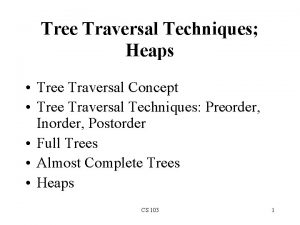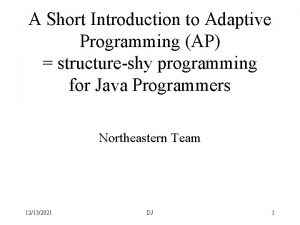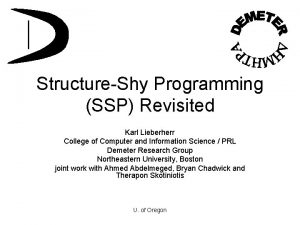StructureShy Programming Ahmed Traversal StructureShy Programming Traversal Strategy


















- Slides: 18

Structure-Shy “Programming” Ahmed

Traversal Structure-Shy “Programming” Traversal Strategy Structure “from. . To. . ” Object o; Object. Graph. Slice Visitor • Well defined event generation semantics • DFS Traversal • Generates two types of events: • Before visiting node • after visiting node • A set of Event handlers. Visitor is tied to events rather than structure. Structure-shyness through Indirection!

“Programming” Vs. Traversal • “Programming” = Traversal + Search + Transformation + … • Traversal can be used to implement search. Therefore, structure-shy traversal => structureshy search. • Traversal can be used to implement transformation. Therefore, structure-shy traversal => structure-shy transformation. • Traversal can be used for “programming”. Therefore, structure-shy traversal => structureshy “Programming”.

But, • Is it convenient to implement search, transformation, … using traversals? • “Visitor Formula. Reduce(Formula F, Lit lit) = Copy. Visitor(F) except { • • -----remove Lit thiz if lit != thiz replace literal thiz by truelit if lit == thiz Replace literal thiz by falselit if lit. samevar(thiz) replace Clause c by All. True if exists (from c to true. Lit) replace Clause c by All. False if not exists (from c to Lit) } These 4 lines are intended to replace the one page program in the GPCE – Karl Lieberherr, 2007 • After Pos: … submission. ”

But, • Is it convenient to implement search, transformation, … using traversals? • “Visitor Formula. Reduce(Formula F, Lit lit) = Copy. Visitor(F) except { • • -----remove Lit thiz if lit != thiz replace literal thiz by truelit if lit == thiz Replace literal thiz by falselit if lit. samevar(thiz) replace Clause c by All. True if !empty(from c to true. Lit) replace Clause c by All. False if empty(from c to Lit) } empty(from Clause: c? to Lit) replace c by All. False After These 4 lines are intended to replace the one page program in the GPCE submission. ” replace –=Karl Lieberherr, 2007 Have multiple pattern variables and multiple replace After match is found; after all matches, before any match, after replacement Update formula type after reduction Length of clause

Structure-Shy Search Pattern Descriptor Structure ? ? Object o; ? ? Visitor • Well defined event generation semantics • ? ? • Generates ? ? types of events: • ? ? • A set of Event handlers. Visitor is tied to events rather than structure. Structure-shyness through Indirection!

Structure-Shy Search • Event generation semantics: CSP. • Events: – Before any matches/After all matches – Before/After match – … • Pattern: Since we are using CSP as our “well defined” semantics, we’d expect the pattern to be a set of: Variables, Unary Constraints (Domains/types), n-ary Constraints, constraint propagators.

Structural Patterns: Example We’re setting ‘x’ to false. Any clause containing a negative ‘x’ has to be deleted.

Search using Traversals • Traversal Strategy: “from Formula to Literal” • Search logic implemented inside Visitors. • Keep track of the most recent clause/Literal encountered. When a negative literal named ‘x’ is reached, turn on a flag. Delete ‘x’ when the following literal is encountered. • What if ‘x’ is the last node in the list?

Search using pattern matching ? P ? Q ? R • “A Clause or literal ‘P’ has-a Negative literal named ‘x’ which has-a optional literal”. • Now, generated event “Match found” has the whole pattern <? P, ? Q, ? R> as a parameter. • No need to implement the search logic inside the visitor!

Structural Patterns • A pattern specification consists of: – Variables – Unary constraints – N-ary constraints – Propagators

Structural Patterns N-ary Constraints ? P ? Q Unary Constraints: ? P is either a Clause or literal, ? Q is a Negative literal named ‘x’. ? R is a maybe literal. Propagators: none ? R Variables

Propagators • Given a value for one of the variables, reduce the domain of values for other variables (inference). • Suppose that after deleting a node we need to do some housekeeping at the clause. Now, we have to use the following pattern.

Propagators Propagator • Propagator are specified at high level as “Traversal Strategies”! • Structural patterns are the general case of traversal strategies.

User-Defined Variable Types • A pattern defines a set of possible “instantiations” in the host graph. • A pattern is considered as a user-defined type. • When a variable is assigned to a userdefined type, that means that the possible values that variable can assume are the possible instantiations of that pattern. • Modularity in specifying patterns.

Structure-Shy Transformation Structure Transformation Descriptor. Object o; ? ? Visitor • Well defined event generation semantics • ? ? • Generates ? ? types of events: • ? ? • A set of Event handlers. Visitor is tied to events rather than structure. Structure-shyness through Indirection!

Structure-Shy Transformation • Event generation semantics: Graph Rewriting. • Events: – – – Before anything/After everything Before/After delete Before/After replace Before/After rule fires Before/After structure fix … • Transformation Descriptor: A set of rewriting rules.

Structure-Shy Transformation • Essentially the same as what Karl proposed. • “Visitor Formula. Reduce(Formula F, Lit lit) = Copy. Visitor(F) except { remove Lit thiz if lit != thiz replace Clause c by All. True if there exists (from c to thiz: Lit) lit = thiz replace Clause c by All. False if for all (from c to thiz: Lit) lit != thiz }” • First, Do a normal copy then apply the following 3 rewriting rules to the copied formula. • remove Lit thiz if lit != thiz replace Clause c by All. True if there exists (from c to thiz: Lit) lit = thiz replace Clause c by All. False if for all (from c to thiz: Lit) lit != thiz }
 Ahmed muhudiin ahmed
Ahmed muhudiin ahmed Victoria school ghazipur
Victoria school ghazipur Uv.khayyam
Uv.khayyam Adel ahmed alalla
Adel ahmed alalla When the united indian patriotic association was set up
When the united indian patriotic association was set up Ahmed salman rushdie
Ahmed salman rushdie Ahmed salemi
Ahmed salemi Musul salyaneli mi salyanesiz mi
Musul salyaneli mi salyanesiz mi Dr mohammed ahmed
Dr mohammed ahmed Saad ahmed javed
Saad ahmed javed Ahmed mustapha
Ahmed mustapha Ideology of pakistan by sir syed ahmed khan
Ideology of pakistan by sir syed ahmed khan Is an extended erp module
Is an extended erp module Dr mohammed ahmed
Dr mohammed ahmed Ahmed helmy uf
Ahmed helmy uf Dr fawad ahmed
Dr fawad ahmed Anna molka ahmed artworks
Anna molka ahmed artworks Amina ahmed md
Amina ahmed md Aida ahmed
Aida ahmed
